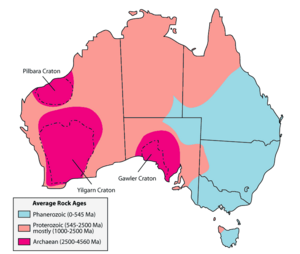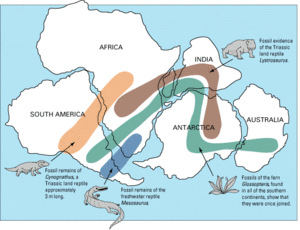Natural history of Australia facts for kids
The natural history of Australia tells the amazing story of how this continent and its unique plants and animals came to be. It was shaped by the geological changes of the Australian landmass. It also changed with global climate shifts over millions of years. These events created the special plants and animals we see in Australia today.
Contents
Earth's Oldest Rocks: The Precambrian Era
Some of Australia's oldest rocks are more than 2.5 billion years old. These ancient rocks are found in three main areas. They are in the Yilgarn and Pilbara regions of Western Australia. You can also find them in the Gawler area of South Australia.
During the Proterozoic era, from 2,500 to 545 million years ago (Ma), more land formed around these old rock areas. This included layers of banded iron formations. These layers also created Australia's main sources of valuable metals. These metals include gold, copper, lead, zinc, silver, and uranium.
Scientists believe these separate land pieces joined together. This happened through tectonic collisions. These collisions formed a huge supercontinent called Rodinia. This event took place between 1300 and 1100 Ma. The western parts of Australia joined first. Then, the southern part connected between 830 and 750 Ma. The Centralian Superbasin formed where these land pieces met.
Rodinia started to break apart between 830 and 745 Ma. Around 750 Ma, a part of Rodinia called Laurentia broke away. This created a huge gap that later became the Pacific Ocean. The remaining landmass included Australia, India, and Antarctica.
The ancient rocks from the Pilbara region hold some of the first signs of life. These are primitive cyanobacterial mats called stromatolites. You can also find fossils of soft-bodied organisms from the Ediacaran period. These are known as the Ediacaran biota. They are found in sandstone around the Flinders Ranges in South Australia. A famous spot for these fossils is Wilpena Pound.
Gondwana: A Giant Southern Continent
After Rodinia broke up, Australia, India, and Antarctica formed a large landmass. Between 750 and 500 Ma, South America and Africa moved closer. By 500 Ma, they had joined with India and Australia. This created the supercontinent known as Gondwana.
During the Paleozoic era, from 545 to 251 Ma, Australia's land changed a lot. From 545 to 390 Ma, warm, shallow seas covered parts of central Australia. In the east, there were chains of volcanoes and deep ocean sediments. The Larapinta Seaway stretched across central Australia between 480 and 460 Ma. New land formed in eastern Australia through cycles of sediment and volcanic activity. A major mountain-building event happened in eastern Australia from 387 to 360 Ma. The continent was also affected by glaciers around 330 Ma.
The continents that had drifted apart from Rodinia came together again. Gondwana, Laurussia, and Siberia collided. This formed another supercontinent called Pangaea during the Devonian and Carboniferous periods. This happened about 350 million years ago. Pangea did not last long. It began to break apart in the early Jurassic period. While Pangea existed, it allowed plants and animals to mix across different landmasses.
During the Carboniferous period, glaciers caused a lot of erosion. This continued into the Early Permian. Around 295 Ma, the Earth's crust stretched and sank. This formed shallow basins where thick coal deposits were created.
Life in the Mesozoic Era
During the Mesozoic era, from 251 to 140 Ma, Earth became much warmer. The Australian landmass was covered with wide river plains. Humid conditions led to the formation of peatlands, especially in the east. Dinosaurs, reptiles, and early mammals lived in Australia during this time. Between 140 and 99 Ma, sea levels rose. Much of the continent was covered by water. In the same period (120 - 105 Ma), more volcanic activity happened in eastern Australia. This uplift created the Tasman Sea to the southeast and the Coral Sea to the north.
The oldest land plants found in Australia are from the Upper Silurian and Lower Devonian periods. They are in marine sediments in Victoria. These plants are called the Baragwanathia Assemblage. Their most famous member is the simple vascular plant called Baragwanathia. These early plants were small and needed water to reproduce. During the Devonian, the first shrub-sized to tree-sized plants appeared in Australia and Antarctica. They were the main type of plant until the Early Carboniferous. As Australia moved away from the equator, these plants were replaced by seed-ferns.
Most of Australia's modern animals began to appear in the Cretaceous period. From pollen records, scientists think that the plants of the Cretaceous either grew in the Australia-Antarctica region or came from Antarctica. Angiosperms (flowering plants) first appeared in the northern Gondwana/southern Laurasia region. They then spread worldwide. An important early flowering plant was the Nothofagus tree.
Fossils found at Lightning Ridge, New South Wales, show that 110 million years ago, Australia had different types of monotremes. These are egg-laying mammals like the platypus. However, there were no marsupials (pouched mammals) at that time. Marsupials seem to have evolved in the northern hemisphere during the Cretaceous. A 100-million-year-old marsupial fossil, Kokopellia, was found in Utah. Marsupials then spread to South America and Gondwana.
The first evidence of marsupials in Australia comes from the Tertiary period. This was found at a 55-million-year-old fossil site in Murgon, Queensland. The Murgon fossil site has many marsupial fossils. Many of them show strong links to South American marsupials. This is not surprising, as both continents were part of Gondwana. At Murgon, scientists also found evidence of a placental mammal, Tingamarra porterorum. Placental mammals were also found in North and South America at this time. This suggests that placental mammals did live alongside marsupials in Australia early in the Tertiary. However, only marsupials continued to thrive in Australia.
Australia's Isolation and Unique Wildlife
Australia separated from Gondwana 99 Ma. At first, it stayed warm and humid, with lots of rainforests. Inland Australia had many rivers and lakes. It was full of wildlife. Fossils of birds, platypus, frogs, and snakes are found from this time.
Around 30 Ma, the Earth began to cool globally. From 15 Ma, the Antarctic ice sheet formed. Sand deserts and large inland salt lakes appeared in Australia within the last 5 Ma. During the Pleistocene (the last million years), the climate changed many times. This led to repeated ice ages with lower sea levels. These low sea levels connected Australia to New Guinea. Warmer periods between ice ages had higher sea levels.
As early as the Miocene (23 to 5.3 Ma), and into the Pleistocene, the Australian megafauna developed. These were very large animals. The megafauna died out in the late Pleistocene. This happened at the same time as climate change and the first human arrival in Australia. Some studies suggest that the fire-stick farming methods of Indigenous Australians changed plant life. This may have contributed to the extinction of large plant-eating animals. An example is the huge flightless bird, Genyornis.
The Naracoorte Caves National Park in South Australia is a World Heritage Site. It has the best record of Australia's megafauna. Placental mammals reappeared in Australia during the Pleistocene. This happened as Australia moved closer to Indonesia. Both bats and rodents began to appear in the fossil record. Australia's long isolation created a clear boundary between Australian and Asian animals. This boundary is known as the Wallace Line.



